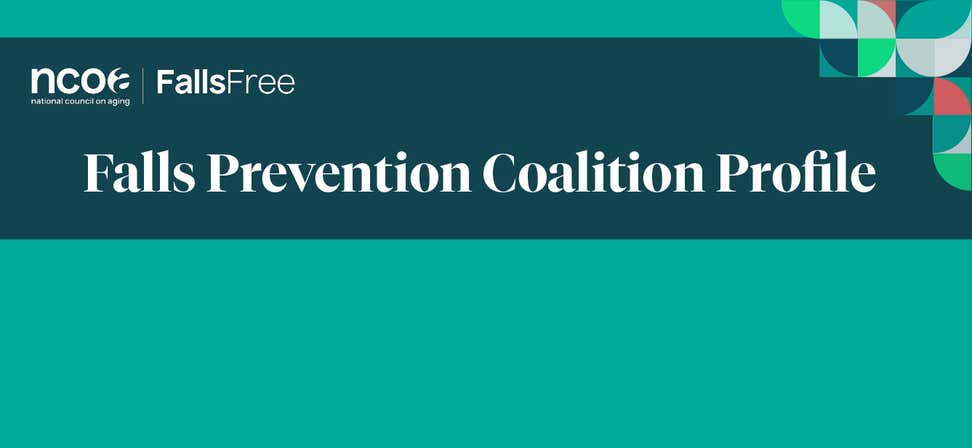In Texas, the Falls Prevention Coalition has undergone several leadership changes and a name change, meanwhile strengthening its mission to create lasting change to reduce falls in diverse communities across the state.
The history of the Texas Takes on Falls Coalition
From 2007 to 2011, the Texas Falls Prevention Coalition (TFPC) was under the leadership of the Texas Association of Area Agencies on Aging (T4A). In 2007, T4A submitted a grant application to the Department of Aging and Disability Services (DADS) and received a $200,000 grant to implement the A Matter of Balance Lay Leader model in Texas. Drs. Marcia Ory and Matthew Smith were involved in the evaluation of the project, and 77 Master Trainers and 55 Coaches were trained, while 1,100 older Texans participated in A Matter of Balance.
In 2008, another $200,000 was awarded by DADS to TFPC. The coalition consisted of 25 of 28 AAAs. A part-time TFPC coordinator was hired. In September 2008, Humana became the statewide sponsor and awarded TFPC $100,000. In 2008, the Governor of Texas signed a Proclamation in recognition of Falls Prevention Awareness Day.
From 2011-2014, TFPC leadership transferred to Area Agency on Aging of Tarrant County. The coalition broadened its focus and was expanded to the Evidence-based Programs Coalition.
In 2014, Texas A&M University assumed leadership of TFPC. Marcia Ory, PhD, MPH, of Texas A&M University, formed a steering committee to guide the work of the coalition, and TFPC grew to over 100 organizations. TFPC coordinated Falls Prevention Awareness Week, local events, and educational opportunities. TFPC had a quarterly newsletter and worked with the state to create the Governor’s Proclamation. In 2017, Matthew Smith, PhD, MPH, CHES, also of Texas A&M University, led efforts to transform TFPC to the Active for Life Coalition. Active for Life combined falls prevention and chronic disease, broadening its areas of focus and making it more encompassing.
In 2022, coalition leadership transferred to Texas Healthy at Home and WellMed Charitable Foundation. The coalition’s focus narrowed once again to falls prevention, and its name changed to Texas Takes on Falls Coalition. A Strategic Planning Committee was formed, and the 2022-2024 Texas Takes on Falls Mission and Strategic Plan were developed.
Current goals and objectives for the Texas Takes on Falls Coalition
The Texas Takes on Falls Coalition mission: Create systemic lasting change that reduces falls in diverse communities across Texas.
Goals
- Develop educational, advocacy, and modern media materials to raise awareness among influencers, advocates, and policy makers of risk factors, incidence, impact, costs, and promotion of fall prevention efforts in Texas.
- Create policy change that utilizes existing government funding streams to incentivize uniform implementation of falls prevention programs throughout Texas.
- Advocate for health and social equity in fall prevention programs for older adults while ensuring that all communities are served based on the needs of each individual, irrespective of race, color, age, disability, economic status, and geographic location.
Goal 1 Objectives:
- Develop education, advocacy and modern media materials to promote state and federal fall prevention weeks.
- Disseminate education and advocacy materials via email, social media, and news releases.
- Create five strategic alliances between healthcare entities and community organizations to identify fall prevention needs.
- Promote and showcase effective fall prevention strategies and programming that can be replicated across the state at Texas Takes on Falls Strategic Planning Committee meetings three times per year.
Goal 2 Objectives:
- Gather falls data by state and/or county level to determine incidence of falls.
- Pursue and solidify at least five statewide association partnerships that have a vested financial interest in reducing fall related costs.
- Hold conversations with at least 10 key state and local elected officials, advocacy organizations and associations about the importance of falls prevention.
- Develop proposed legislative language to be incorporated into law or regulation.
- Identify a fall prevention assessment tool that can be completed by a wide range of partners and organizations for utilization in a statewide funded initiative.
- Identify funding that can be used to support the above.
Goal 3 Objectives:
- Complete statewide Culturally and Linguistically Appropriate Services training.
- Complete statewide workshop on best practices for addressing health disparities and social determinants of health.
- Apply for 2023 U.S. Administration for Community Living falls prevention grant and ensure proposal addresses a continuum of fall risk level programs and focuses on health equity for underserved populations.
- Provide ongoing technical assistance to local communities in (1) developing falls prevention programs that address health equity for underserved populations and (2) employing a data collection and analysis strategy to demonstrate the impact of falls prevention efforts.
Leadership for the Texas Tales on Falls Coalition
- WellMed Charitable Foundation, Co-Lead: Debbie Billa dbilla@wellmed.net
- Texas Healthy at Home, Co-Lead: Christina Bartha; c.bartha@texashealthyathome.org
Key Partners for the Texas Takes on Falls Coalition
- Aetna
- Arlington Fire Department
- BakerRipley
- Baylor Scott & White Health
- Capital Area Council of Governments Area Agency on Aging
- Care 'N Care
- Coastal Bend Council of Governments Area Agency on Aging
- Concho Valley Council of Governments
- Community Council of Greater Dallas
- DFW Hospital Council Foundation
- Deep East Texas Council of Governments Area Agency on Aging
- Heart of Texas Council of Governments Area Agency on Aging
- Lewisville Fire Department
- MedStar Mobile Healthcare
- Molina Healthcare
- North Central Texas Council of Governments Area Agency on Aging
- Pat Gleason-Wynn, PhD, LCSW, CSW-G, BSN, RN-BC
- Sixty & Better
- Texas A&M Agrilife Extension
- Texas A&M School of Public Health
- Center for Community Health and Aging
- Center for Health Equity and Evaluation Research
- Texas Health and Human Services
- Texas Health Resources
- Texas Healthy at Home
- United Way of Tarrant County
- University of North Texas Health Science Center
- University of Texas at Arlington
- WellMed Charitable Foundation
- Wellpoint
What has the Texas Takes on Falls Coalition achieved?
- The Texas Takes on Falls Strategic Planning Committee completed and approved the Coalition’s 2022-2024 Strategic Plan. Workgroups were recently formed to achieve the goals and objectives in the strategic plan.
- The coalition expanded to include 30 multisector organizations representing academic institutions, first responders, health care entities, community-based organizations, community-based volunteers, and government entities.
What are the current challenges for the Texas Takes on Falls Coalition?
- Lack of consistent use by coalition members of the technology hub Juniper to post and track statewide falls prevention classes, volunteers, outputs, and outcomes. To address this challenge, all coalition members will be given the opportunity to post and promote falls prevention classes before and during 2023 Texas Falls Prevention Awareness Week.
- Lack of funding to support coalition activities, website development, and the technology hub Juniper. To address this challenge, we are exploring various funding options and opportunities.
What evidence-based falls prevention programs are currently offered by the Texas Takes on Falls Coalition?
- A Matter of Balance
- Bingocize
- Tai Chi for Arthritis and Fall Prevention
- Tai Ji Quan: Moving for Better Balance
- Stay Active and Independent for Life (SAIL)
- Texercise Select
- HomeMeds
What outcomes are monitored by the Texas Takes on Falls Coalition?
- Development of educational, advocacy, and modern media materials to raise awareness among influencers, advocates, and policy makers of risk factors, incidence, impact, costs, and promotion of fall prevention efforts in Texas.
- Create policy change that utilizes existing government funding streams to incentivize uniform implementation of falls prevention programs throughout Texas.
- Uphold health and social equity in fall prevention programs for older adults while ensuring that all communities are served based on the needs of each individual, irrespective of race, color, age, disability, economic status, and geographic location.








